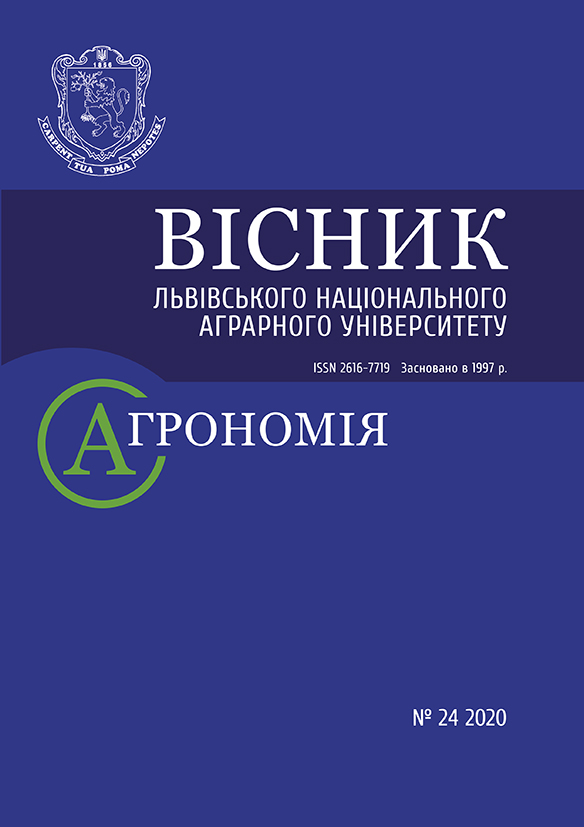Visnyk LNAU: Agronomy 2018 №22(2): 25-28
Formation of nutrient regime of soil in short-rotation crop rotation
Kachmar O., Candidate of Agricultural Sciences
Vavrynovych O., Candidate of Agricultural Sciences
Dubytskyу O., Candidate of Agricultural Sciences
Dubystkyi A., Candidate of Agricultural Sciences
Shcherba M., Research Officer
Institute of Agriculture Carpathian region NAAS
https://doi.org/10.31734/agronomy2018.02.025
Annotation
The influence of fertilizer systems and precursors on the formation of nutrient regime under cultures in short rotation crop rotation is investigated. It was established that the highest content of alkali hydrolyses nitrogen (13,68 and 11,49 mg / 100 g of soil), mobile phosphorus (14,26 and 12,75 mg/100 g of soil) and exchangeable potassium (12,13 and 10,65 mg/100 g the soil) under winter wheat in the arable and subterraneous layers was at the time of the restoration of the spring vegetation, after the forerunner of winter wheat in grain crop rotation in the variant of direct introduction into this culture of organic-mineral fertilizers. The combined application of potatoes in grain-driven and fertile crop rotations of mineral fertilizers at a dose of N90P90K90 and manure (40 t/ha) at the time of seedlings of culture in the arable layer provided the most intense accumulation of alkali hydrolyzed nitrogen: 12,87–13,0 mg/100 g of soil, mobile phosphorus: 13,47–13,58 mg/100 g soil, exchangeable potassium: 11,69–11,85 mg/100 g soil. Mineral fertilizers at a dose of N45P45K45 and plowing of straw of oats contributed to the formation of a nutritional regime in pea crops at the level: alkali hydrolyzed nitrogen – 11,77–11,86, mobile phosphorus – 12,79–12,86 and exchangeable potassium – 11,47–11,56 mg/100 g of soil in both one hundred percent grain crop rotations.
On the formation of a nutrient regime of the soil under crops in short-rotation crop rotation, both organic-mineral fertilizer systems and predecessors have a significant influence. The combined application of manure with mineral fertilizers (traditional organic-mineral fertilizer system) and straw, green manure and half doses of mineral fertilizers (an alternative organic-mineral fertilizer system) provide an increase in the content of moving forms of nitrogen, phosphorus and potassium in both the arable and subsoil soils of the soil, an increase in the number of plant remains and contribute to the formation of positive values in the balance of these elements of nutrition.
Key words
short rotation crop rotation, fertilizer systems, nutritional regime
Link
- Boyko P., Glayncev A., Pshenychnaya S., Vetrov V. Effect predecessors accommodations major crop rotation their productivity, the productivity of crop rotation and soil fertility. Agriculture. 1980. N 51. P. 55–60.
- Boyko P., Borodan V., Kovalenko N. Environmentally sustainable crop rotation – the basis of biological agriculture. Visn. agriculture science. 2005. N 2. P. 9–13.
- Kachmar O., Vavrinovich O., Shcherba M. Effect of fertilization on productivity in terms of crop rotation korotkorotatsiynyh Western Ukraine. Agriculture. Interdepartmental thematic scientific collection. Kyiv: ECMO, 2015. Vol. 1. P. 38–46.
- Lebed E., Desyatnik L. Rotation based agrobiological feasibility of placing crop. Proceedings of Sciences. Proceedings of the Institute of Agriculture. Kyiv, 2004. P. 19–22.
- Crop rotation in agriculture Ukraine / ed. V. Sayka, P. Boyko. Kyiv: Agricultural Sciences. 2002. 146 p.
- Tsvey Y. Soil fertility and productivity of crop rotation: monograph. Kyiv: CPU "Komprynt", 2014. 415 p.
- Shilina L., Litvinov D., Ermolaev M. et al. The effectiveness of the elements of biological farming systems. For science: NSC papers "IAU UAAN" Kyiv 2006. Special edition. S. P. 61–74.



